For many years, anyone going through Cincinnati’s Union Terminal after 1931 was most likely greeted by a series of murals, each depicting hard working citizens going about their jobs. And each also had some connection to the city itself.
Like many forms of art, most people walked past the murals without giving it that much thought. Others might absent mindedly walk past the murals with a sigh of relief – a visual symbol that they were finally home. I also like to think that children, when passing the murals with their parents would point and say, “Mommy! Why did someone make a mural of a dude building a piano?” and the mom would pat little Timmy on his head and say, “I don’t know, son. If I don’t understand it, It’s gotta be ‘art’.”
Occasionally, usually on some random anniversary or something, a story would be printed in the local newspaper or magazine, often discussing how they were made or generally focusing on some minor aspect. For example, in 2013 the Cincinnati Enquirer printed a series of articles that went something like this: “Hey, you know those murals? Who were those people in real life? And what do they represent?” To which everyone in town just mumbled something as they turned and walked away.
This was a mystery that several at the Cincinnati Enquirer really believed should be solved, if possible. History doesn’t get more iconic than a series of murals celebrating the city’s history … and heck, Tom Cruise and Dustin Hoffman walked past them in the movie Rain Man, preserving the murals in the annals of cinematic history if nothing else. How is it possible that nobody really knows all that much about them? (Grumble … idunnow …. slowly walking away)
The Winold Reiss Industrial Murals
The murals in question are the Winold Reiss industrial Murals and were created by a guy named (obviously) Winold Reiss, a German-born artist who came to America in 1913 where he spent many years working with the Blackfeet Tribe of the Blackfeet Indian Reservation of Montana. (If you’re wondering where this is on a map, it’s just east of Glacier National Park.) Here, he painted upwards of two hundred and fifty paintings of Native Americans, many of which were used for calendars printed by the Great Northern Railway.
In 1931, he was commissioned to do a series of murals for Cincinnati’s Union Terminal to celebrate the city’s advancements and I suppose make the walls less boring. For this, he would be paid $21,000, which was no small sum in the 1930s.
Each mural would begin with a photograph. From this, he would create a 30 x 22 inch simple illustration using Conté crayons. The maquette would then be made roughly a third of the size of the final mosaic. Finally, all these things would be shipped to St. Louis (and possibly New York City) where it would be enlarged as the tiles would be created. When this was done, the final product would be sent back to Reiss in Cincinnati, who would begin to put the murals in place.
Who Are These People? The Cincinnati Enquirer Asked?
While it was well documented that Reiss went around to various industries and photographed workers, for the longest time nobody knew which places he went to, and who specifically posed for his camera. Being that this was supposed to be a celebration of the various Cincinnati industries, focusing on the workers who (it can be easily argued) helped build this city – shouldn’t we be able to learn who we are looking at when we view the mural.
Let’s put it this way:
This mural depicts one of the city’s piano makers. Cincinnati was once home to several of the best Piano makers in the nation.
Or, it could be put this way:
This mural depicts Clem Vonderheide, an immigrant born in Germany but who landed in the Cincinnati area. When he married his wife, Anne, he was working as a laborer with the railroad industry, however before long he would quit that job and go to work for the Baldwin Piano Company, which had already established its name for having some of the best products in the industry. Clem lived a simple life with his wife, and stepson Albert, regularly attending church and living a modest life. We also know that Clem lost an eye in a minor incident at the Baldwin plant that sent a splinter through his retina. After seeking medical attention, he returned to the job so that he could continue to provide for his family. His story is typical of the German immigrants who were helping to populate the city at the time.
(NOTE: For the record, both statements are factually correct. The “piano maker” mural does depict Clem Vonderheide.)
Up until 2013, the identities of the specific people depicted in the murals wasn’t known until a dedicated group of fine people from the Cincinnati Enquirer spent months searching through records, reports, even family genealogies trying to solve the mystery.
These murals were supposed to commiserate “the average man” who believed that hard work could accomplish anything. They were commissioned during The Great Depression so that played into the concept and design, too.
The identities of the subjects, or what companies they worked for was never the point. History has a way of celebrating the names boldly displayed on the sides of buildings, while the people who placed the bricks are all but ignored. However, without them and their hard work, none of this would even be possible.
That being said, knowing who is depicted does (at least today) add a new dimension to the story. All of the stories collected by The Enquirer tell of strength and dedication, of developing a work ethic that builds proverbial foundations – and quite often (as is the case with Clem who lost an eye) overcoming hardships.
Where Are the Murals Today?
As I said above, the murals were commissioned for Cincinnati’s Union Terminal in 1931 and after that they adorned the walls to be enjoyed by anyone walking past. Unfortunately, that all changed in 1972 when the powers that be decided it was time to demolish the concourse, they were housed in without any regard to saving anything. Thankfully, a small group of people said, “That’s just not right” and started to raise enough money to have them preserved and moved somewhere else.
This group was able to raise four hundred thousand dollars, which was enough to preserve the fourteen murals, but not enough to preserve an additional piece of artwork – a mural map of Cincinnati, which was ultimately lost.
Apparently, moving a mural isn’t all that easy. It isn’t like being able to move a painting where you can remove it from the frame, roll it into a special tube, and tuck it under your arm. First of all, they were HUGE. They were also built into the wall itself, and additional concrete filled in the places without tiles. So, not only was this thing exceptionally large, it was also extremely heavy. Once the plan had been established on what to do with the things, it took crews an additional three months just to figure out how to move them all.
Each panel was encased in steel frames, then lowered into steel cradles. They were wrapped in a protective coating before being encased in Styrofoam, before finally being encased in wooden boxes. Phew – and you thought it was difficult trying to move Aunt Irma’s couch.
When it was finally time to move the murals, that, too, was a slow and painstaking process. As the trucks slowly made their way to the airport, city workers had to rush ahead and remove overhead signs and power cables, then put them back as quickly as they could once the final truck had driven past.
After August 1973, the murals were on display in one of the concourses of Cincinnati’s airport. It was here, several years later, that they just happened to be filming the movie Rain Man, which is how they began to appear in movie theaters all across the land.
In 2015, the airport terminals were set to be demolished and yet again someone had to figure out what to do with the now historic murals. (For the record, it was shortly after this was announced, a couple of years in advance, that the Cincinnati Enquirer folks began looking into who all was depicted in the murals and trying to figure out what they all meant.)
This time the murals were moved to the Duke Energy Convention Center, which is a couple of blocks west of Fountain Square, or a few blocks north of Paycor Stadium, depending on which direction you want to approach the murals from.
Also in 2015, two artists named Matthew Lynch and Curtis Goldstein made modern representations of the murals out of Formica, which I hear is a lot lighter and easier to move. These began to be displayed in the Weston Art Gallery in 2018, along with the original photographs, crayon drawings, and other materials from the Reiss archives.



